A digital transformation technology means that technologies are integrated into all business workflows, fundamentally change how a company operates, and offer added value to its customers.This digital transformation technology uses various digital tools and platforms to optimize processes, increase efficiency, and transform business most innovatively.
Overall, companies spend their budget on transformation to reshape business models, improve the customer experience, and remain competitive. At LaSoft, we’ve seen firsthand how companies evolve through digital transformation initiatives.
In 2023, digital transformation technology spending reached around $2.15 trillion. By 2027, global spending on digital transformation is expected to reach $3.9 trillion. (Source: Statista)
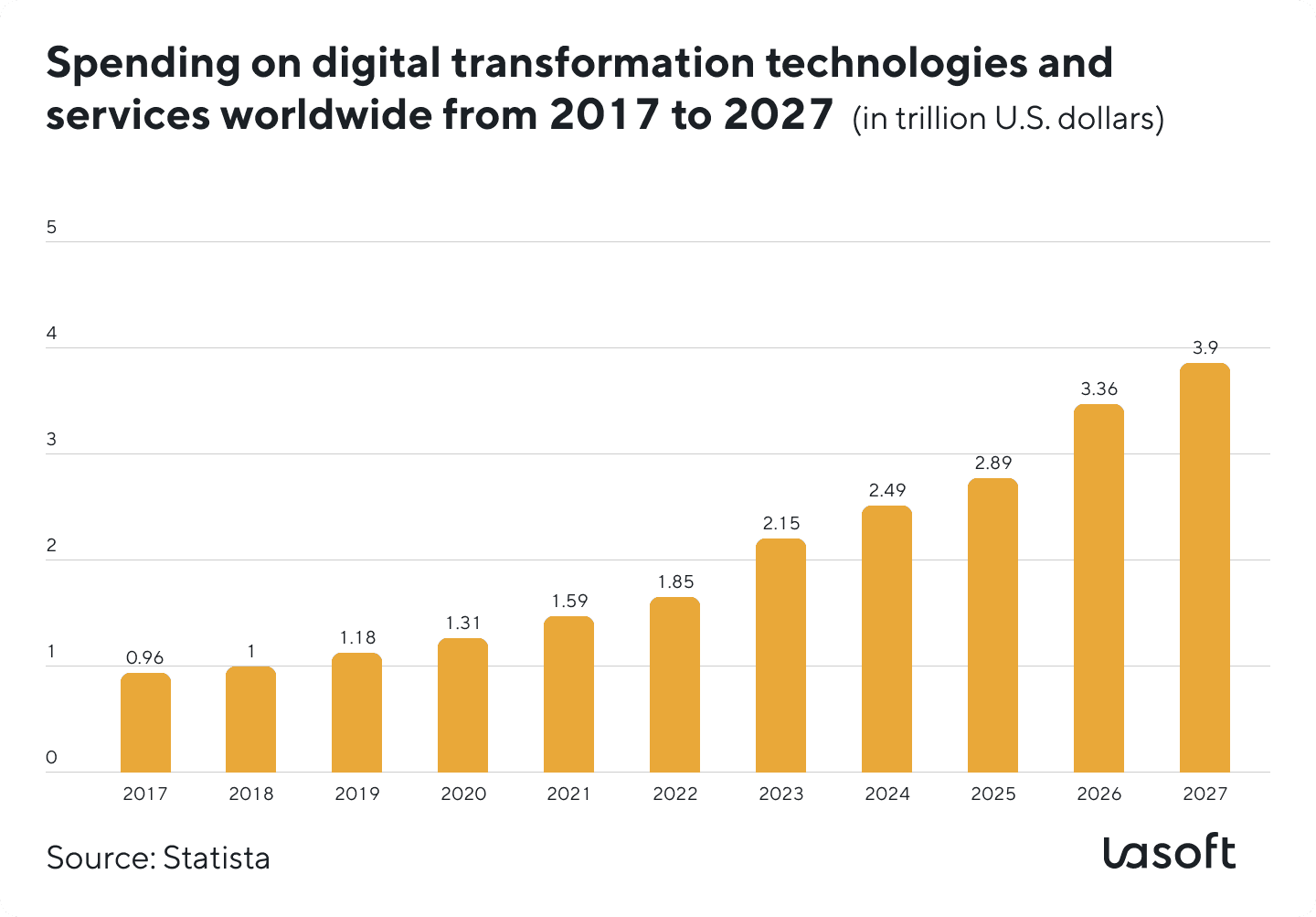
Examples of Digital Transformation
Cloud-Based Collaboration Tools For Project Management
Cloud-based collaboration has popularized solutions such as Microsoft Teams, Google Workspace, Jira, Trello, Mirro, and Slack. These platforms allow teams to interact, share documents, and communicate in real-time. This digital workplace offers document sharing, video conferencing, and instant messaging that improve efficiency and teamwork. While project managers organize all important data in one place, stakeholders can access the information they need at the right time.
Remote Work and Telecommuting
Employees can work from anywhere and utilize virtual private networks (VPNs), cloud computing, and remote desktop solutions to securely access company resources from remote locations. This flexibility has increased employee satisfaction, improved work-life balance, and reduced the company’s overheads.
Automation and Artificial Intelligence (AI)
Automation and AI technologies are transforming the workplace by automating repetitive tasks, optimizing workflows, and augmenting human potential. Chatbots, for example, process customer inquiries and support requests; virtual assistants create a personal interaction effect and reduce the workload of human employees. Robotic process automation (RPA) streamlines back-office processes by automating data entry, invoice processing, and other routine tasks. These technologies increase efficiency, reduce errors, and enable employees to focus on high-value tasks.
Digital Learning and Development
Online training platforms, e-learning courses, and virtual classrooms help your team grow and get new skills. These platforms offer interactive learning experiences, personalized learning schedules, and assessments to stay competitive in the job market.
Data Analytics and Insights
Advanced analytics tools such as business intelligence (BI) dashboards and predictive analytics models enable big data analysis, identification of trends and future tendencies, sales forecasting, customer segmentation, etc. Data analysis helps companies to optimize their performance and drive strategic initiatives.
Digital Security and Privacy
As companies become increasingly digitalized, cybersecurity has become a top priority. Digital transformation has introduced advanced security measures such as multi-factor authentication (MFA), encryption, and endpoint security solutions to protect sensitive data and systems.
HR Digital Transformation Technology
To shorten the time between the interview and onboarding process, the HR team switched from distributing traditional paper forms for offer letters and paperwork to new digital software platforms such as Zenefits, Gusto, BetterUp and others.
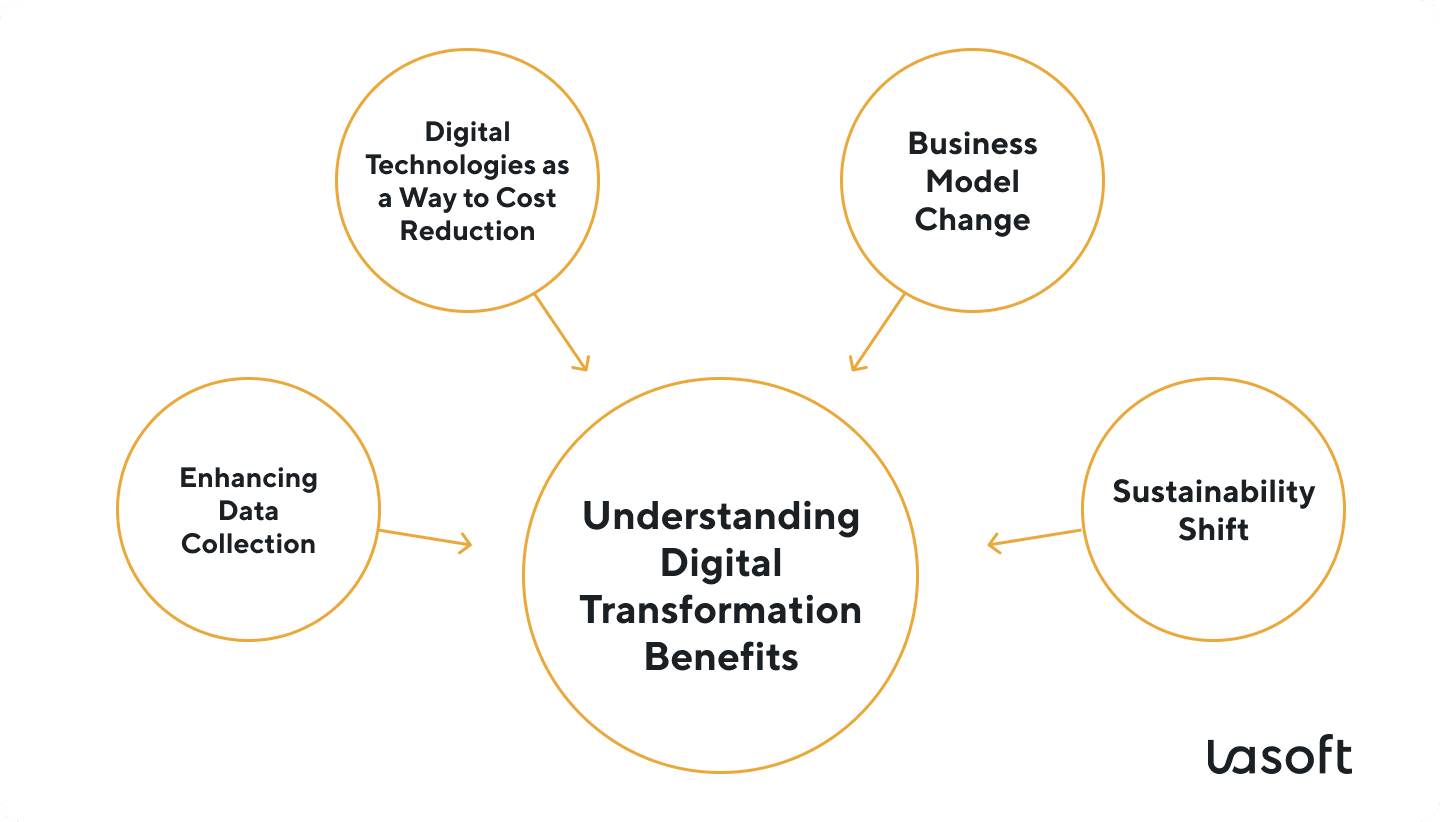
Understanding Digital Transformation Technology Benefits
Integrating digital technology into every workflow stage will fundamentally change the company culture and strategy, deliver successful business results, and add value for your customers. With the right strategy, the value of digital transformation is in growth and ensuring operational efficiency in a rapidly changing digital world.
Enhancing Data Collection
Digital technologies improve business operations and overall efficiency by enhancing data collection. Digital tools consolidate data from multiple sources onto a single platform. This centralization improves the accuracy and accessibility of data. These tools help monitor real-time data, providing deeper insights into customer behavior and preferences.
Digital Technologies as a Way to Cost Reduction
Digital tools save money and time by automating repetitive tasks, reducing the need for manual labor, and freeing up time for other tasks. Going digital reduces reliance on paper-based processes, resulting in cost savings on printing, storage, and physical distribution of documents. It also has a positive impact on the environment.
You can also reduce office rent expenses, as thanks to remote work and platforms like Jira, Slack, and Trello; your staff can work from home, allowing companies to draw experts from any country.
Business Model Change
Digital transformation as a competitive advantage is changing business models and offering new opportunities for efficiency, growth, and customer engagement. Integrating digital technologies leads to a better business model and a more agile approach. Digital tools help to launch new products and services faster and test market reactions. They provide companies with data analytics and enable personalized customer experiences, from targeted marketing to customized product recommendations.
A digitally transformed business model promotes stronger partnerships and collaborations. Companies can join forces with other companies, share resources, and create ecosystems that promote innovation and growth. This approach strengthens the resilience of companies and fosters mutually beneficial relationships.
Sustainability Shift
The digital transformation enables greater energy efficiency through smart technologies. Intelligent building systems can, for example, optimize heating, cooling and lighting based on real-time data. This leads to lower energy consumption and reduces the carbon footprint associated with traditional energy use.
IoT devices can monitor equipment performance, enabling predictive maintenance and reducing unnecessary resource consumption. Data analytics can also optimize supply chains and minimize waste and overproduction.
Companies can also implement more effective recycling and waste management strategies. Data tracking allows companies to identify waste patterns and create programs for recycling or reusing materials, contributing to a circular economy.
Virtual prototyping reduces the need for physical materials during the design process in sustainable product design and development, and 3D printing enables precision manufacturing with minimal waste. This approach encourages innovation while reducing environmental impact.
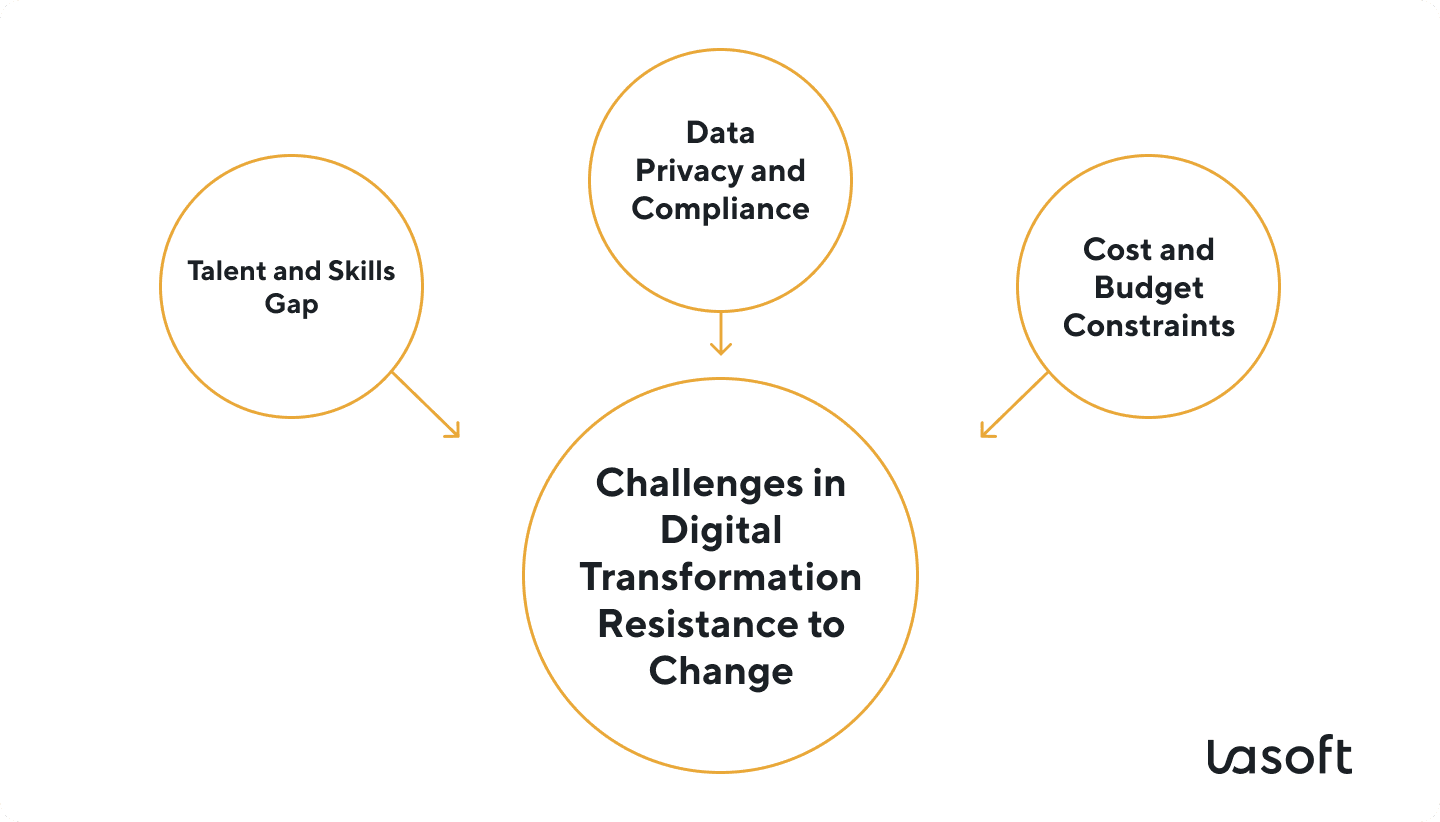
Challenges in Digital Transformation
Digital shifts may also introduce issues. Potential problems include managing the training and learning curve, increased cybersecurity risk, and internal pushback from your staff. Please ensure that while building a new digital business model, you take into account the following challenges:
Resistance to Change
One of the biggest hurdles to digital transformation is employee resistance to change in familiar business processes. Employees may hesitate, preferring to stick with familiar methods. Effective change management, clear communication, and training can overcome this resistance.
Talent and Skills Gap
The rapid technological change in the digital field has created a demand for new skills and expertise. Upskill your employees to enable them to use new tools and processes, and set standards and procedures to guarantee that your teams adhere to the same best practices, such as data analytics, artificial intelligence, and marketing automation.
Data Privacy and Compliance
With increased customer data collection comes greater responsibility for protecting consumer privacy and complying with regulations such as GDPR and CCPA. Ensure robust data governance policies and practices safeguard sensitive information and maintain consumer trust.
Cost and Budget Constraints
Digital transformation can be expensive, especially involving significant changes or custom software development. Budget constraints can limit your planned transformation projects, prioritizing initiatives and finding cost-effective solutions.
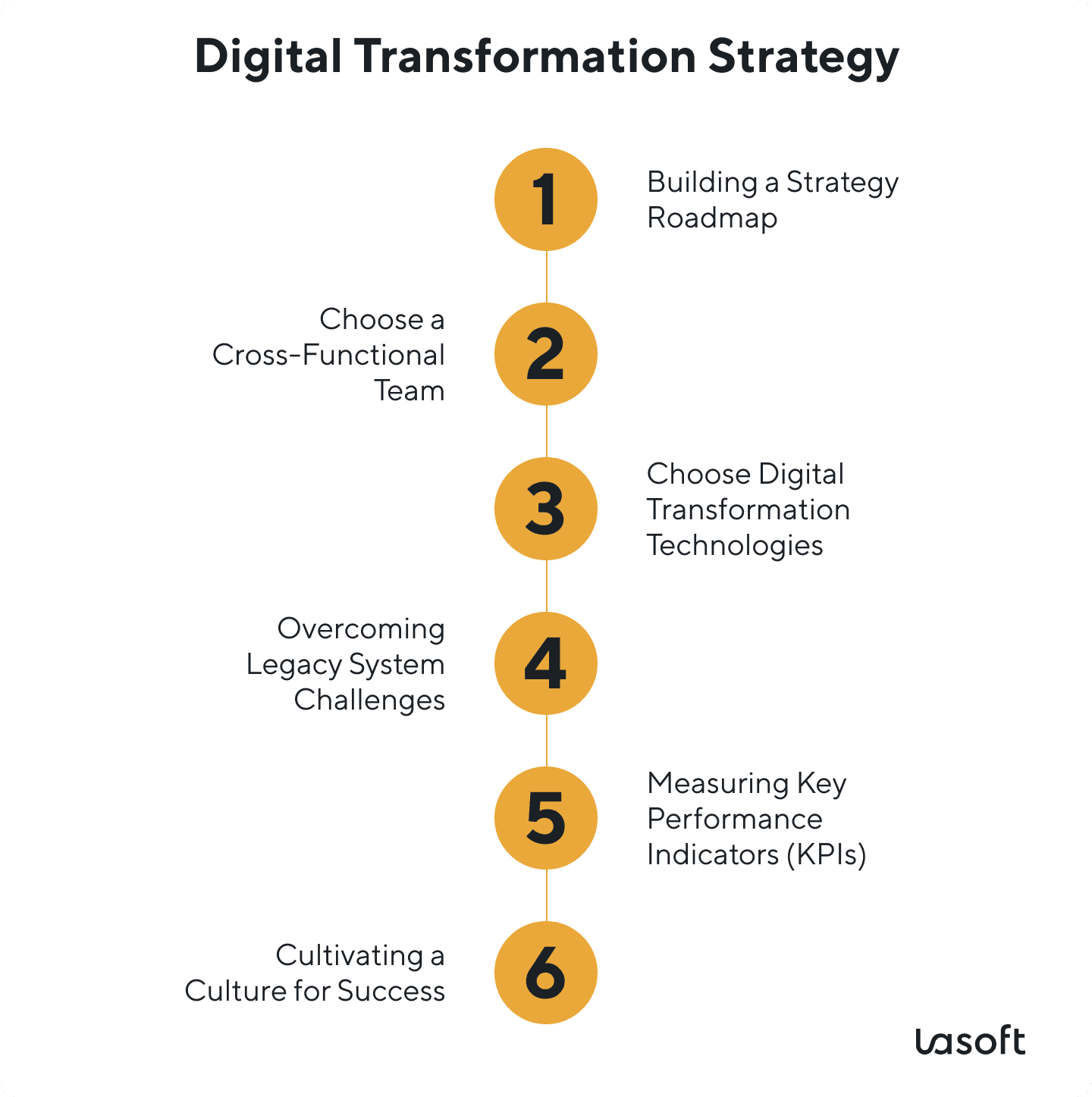
Successful Digital Transformation Strategy
Digital transformation requires strategic planning and execution. From developing a forward-thinking business strategy to leveraging the right technologies and overcoming legacy system challenges, there are several strategic steps that businesses need to take to ensure a successful digital transformation project.
1. Building a Strategy Roadmap
The strategy must align with the business’s goals and involve employees. Identify results you want to achieve, such as improving customer experience, enhancing operational efficiency, or driving revenue growth. Ensure that your objectives are aligned with your overall business strategy and that they are measurable and achievable within the project timeline. Prepare your team for constant changes connected with digital transformation, and make a clear roadmap of changes you plan to introduce.
2. Choose a Cross-Functional Team For Your Digital Initiatives
Collaboration with a cross-functional team is vital to letting your in-house team follow the usual workflow, allowing experts to offer changes, and driving successful digital transformation. It involves moving from traditional models towards agile frameworks, saving you time and money by inviting in-house specialists and professionals who meet deadlines and have the skills to follow industry and market trends.
3. Choose Digital Transformation Technologies
While there are many digital transformation technologies, focusing on core technologies ensures a solid foundation. These core technologies typically include cloud computing, data analytics, and cybersecurity. Build your strategy around these key areas to support your business’s flexibility and data safety.
4. Overcoming Legacy System Challenges
Legacy systems, or legacy technology, pose significant challenges as they can be costly and hinder the implementation of new technologies. For example, your employees may reject changes and even have an inner protest against new tools or products, considering them as a digital disruption to legacy workflows.
5. Measuring the Impact: KPIs for Digital Transformation Efforts
Key Performance Indicators (KPIs) assess the effectiveness of digital transformation efforts. These KPIs measure how the digital transformation initiative affects customer engagement, operational efficiency, and revenue growth.
6. Cultivating a Culture for Successful Digital Transformations
Cultivating a culture that supports digital transformation involves fostering strong leadership, promoting cross-functional collaboration, and setting a mindset of continuous learning and adaptability. Effective leadership also involves authentic leadership and investing in employee training and development.
TOP 3 Digital Transformation Trends
Let’s delve into digital transformation trends, which reflect a shift toward automation, development, and sustainability. By following those trends, businesses can position themselves as competitive and successful in the market.
Artificial Intelligence (AI), Generative AI and Machine Learning
The value of artificial intelligence (AI) for digital transformation is enormous, as it reshapes industries and offers a bunch of benefits. More recently, Generative AI has emerged as a powerful subset of AI, capable of producing content and solutions that required human input before. ML is also a subset of AI focused on building systems that learn from data, identify patterns, and make decisions with minimal human intervention.
Examples:
- AI performs real-time transaction monitoring in financial business.
- In manufacturing, controlling robotic assembly lines.
- Generative AI goes further by automating creative processes such as writing code, composing music, generating marketing copy, and designing graphics.
- AI and ML algorithms analyze vast amounts of data to identify patterns and business insights to process reasonably to support better business decisions by providing predictive analytics.
- Generative AI also generates potential outcomes that can help in strategy development.
- Generative AI takes personalization a step further by creating unique content for individual users, such as personalized emails, custom reports, or personalized learning experiences.
- Generative AI and ML support risk management by modeling various risk scenarios and proposing mitigation strategies, enhancing business resilience.
The AI software market’s global annual revenue is almost $100 billion.
Source: Explodingtopics
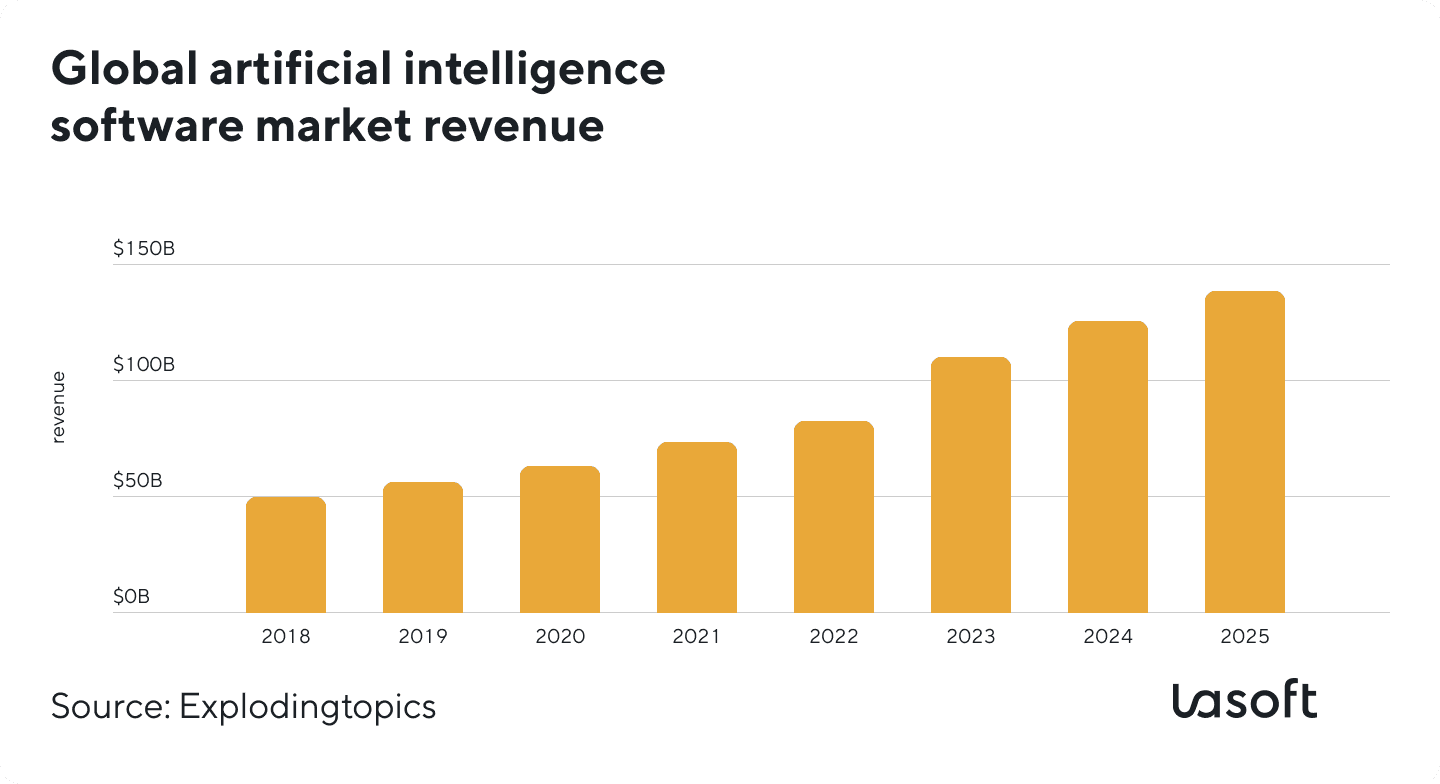
The Internet of Things (IoT)
The Internet of Things (IoT) helps digital transformation across various industries, as physical objects can connect to the Internet and communicate data. Examples:
- IoT devices, like sensors and smart meters, collect data from their environments. This data can include everything from temperature readings and machine performance metrics to user interactions and environmental conditions.
- IoT-enabled machinery can predict and schedule maintenance before breakdowns occur, minimizing downtime.
- In logistics, real-time tracking of goods ensures efficient supply chain management and reduces waste.
- IoT offers personalized experiences through smart home devices and wearable technology. These devices collect user preferences and habits data, allowing businesses to create services and products to individual needs that cover customers’ needs.
The global market for industrial Internet of Things (IIoT) was over 544 billion U.S. dollars in 2022. The market is expected to grow in size in the coming years, reaching some 3.3 trillion U.S. dollars by 2030. Source: Statista
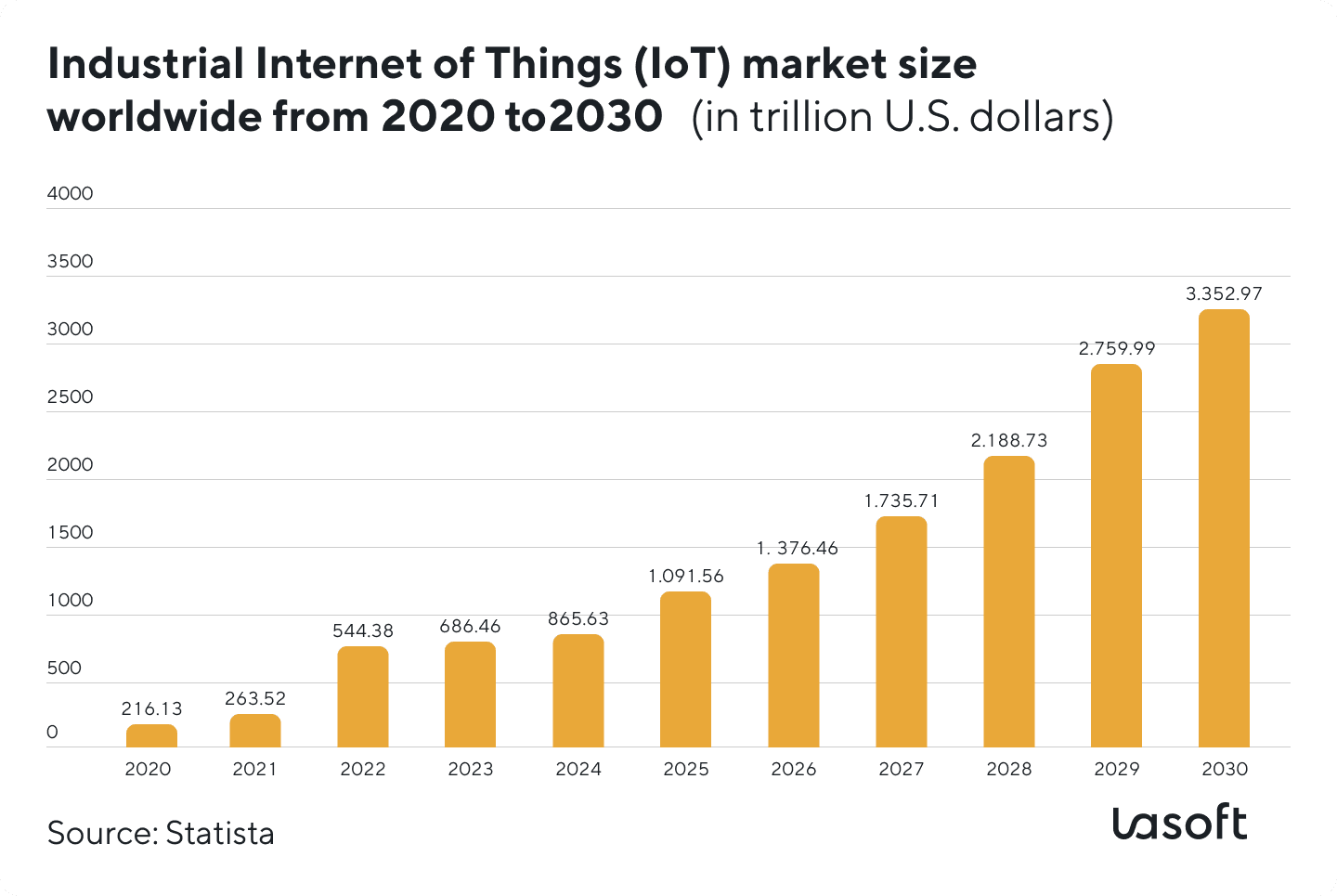
Cloud Computing
Cloud computing has become a cornerstone of digital transformation, reshaping how businesses operate and deliver value to their customers. It helps scale IT resources, be flexible, and use cost-saving technologies.
- Scalability, for example, is essential for handling varying workloads, such as seasonal spikes in retail or real-time data processing in financial services.
- Flexibility allows companies to experiment with new projects without long-term commitments, facilitating innovation and rapid prototyping.
- Due to the shift from capital expenditure (CapEx) to operational expenditure (OpEx), businesses avoid the costs of purchasing, maintaining, and upgrading physical servers and data centers.
- Tools like cloud-based project management software, file sharing, and real-time document editing allow teams to work together more effectively, regardless of geographical location.
- Modern cloud providers offer advanced security features that meet the standards of highly regulated industries like finance and healthcare.
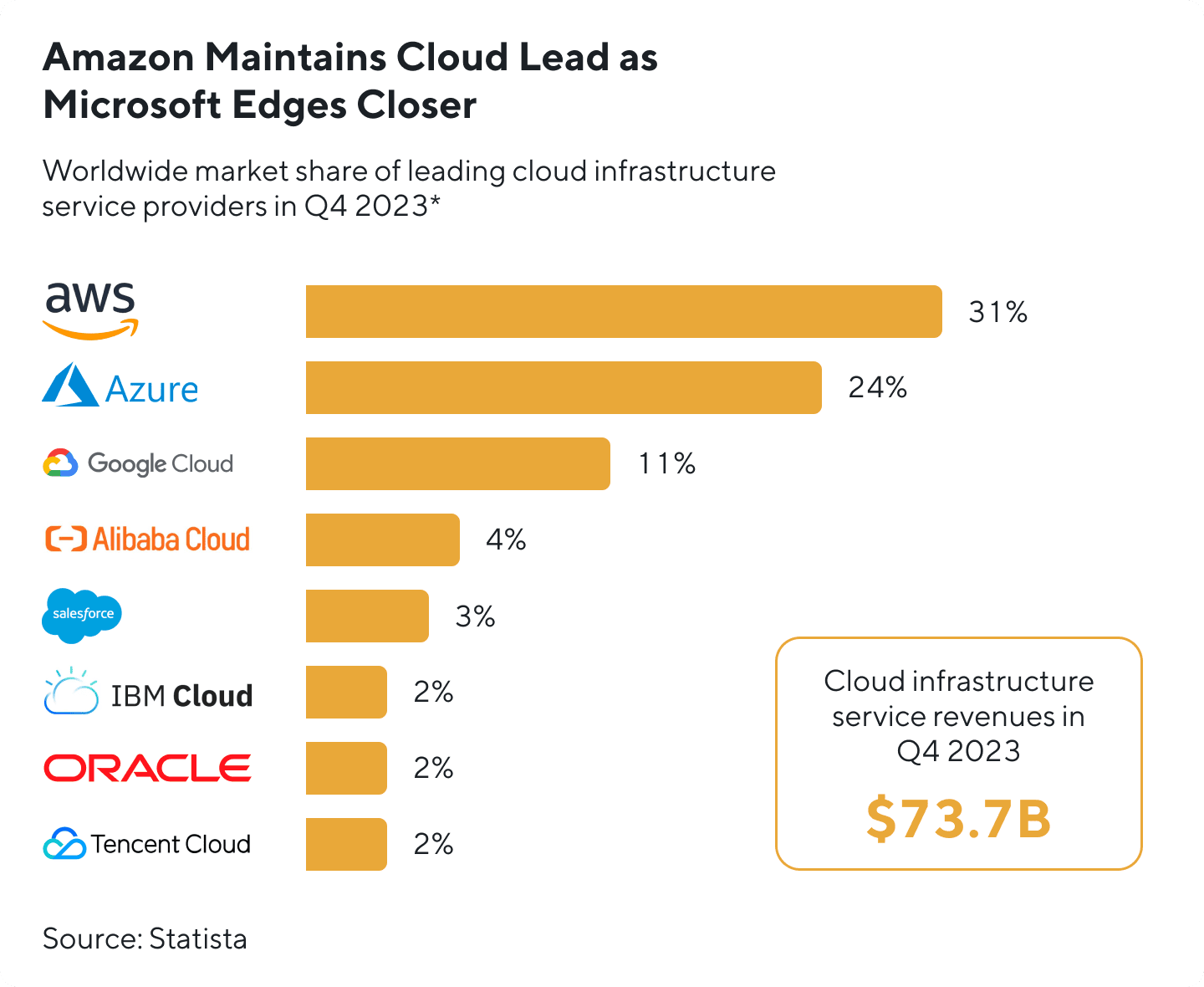
Source: Statista
Case-Study By LaSoft: Call Listening Company
LaSoft offers the tech solution we provided for our customer, Call Listening Company. Our client faced the challenge of assessing their telecommunication services:
- employees performance,
- call quality analysis,
- call campaign performance metrics analysis,
- identify areas for improvement in the call flow, etc.
We developed a comprehensive dashboard for call quality assurance agencies. We offered innovative features and functionalities for the dashboard system, changing how call centers monitor and improve customer interactions. The dashboard system comprises a suite of modules to deliver accurate information and correspond to user requirements. Supervisors can navigate the dashboard’s interface, selecting date ranges and comparison periods for in-depth analysis.
The analysis of calls enhances call quality and customer satisfaction by promptly identifying and addressing problematic trends. The dashboard system boasts a range of modules designed to facilitate performance management and coaching efforts.
The transformation lies in automating and refining the quality assessment process, significantly increasing operational efficiency and offering deeper insights into call center operations.

Summary: How to Improve Business Processes with Digital Transformation Technology
Digital transformation is an ongoing journey that requires strategic planning, the right technologies, a supportive culture, and rigorous performance measurement. As we have seen from real-world examples, the results of a successful digital transformation are significant, offering improved customer experiences, streamlined operations, and innovative new business models.


